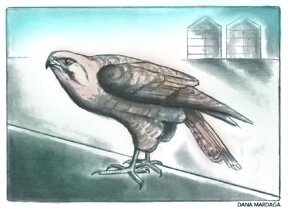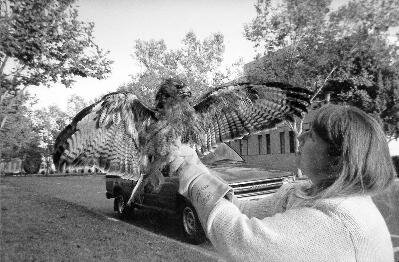
Board of Directors:
President
Martha Kudlacik
Vice-President Operations
Courtenay Dawson-Roberts
Vice-President Education
Sally Peck
Vice-President Publicity
Lisa Stahr
Treasurer
Debbie Schide
Secretary
Beth Visbeck
Director at Large
Lori Isakson
Director at Large
Sandra Skolnik
Director at Large
Jeanne Fouts
Clinical Advisor
Susie Brain
The Rescuer:
Editor
Michele Mandell
Designer
Nancy Rubin
Initial Design by
Marty Johnson
Illustrators
Dana Mardaga
Debbie Melmon
Contributors
Martha Kudlacik
Denny Brisley
Brad Milliken
The Rescuer
Volume XXIV -- Issue One -- March 1998
SUCCESS STORY: Moffett's Fabulous Thunderbirds
by Denny Brisley

We're fortunate in the Bay area to have a wide range of raptors that grace our skies. I've been watching hawks since I was a little girl, and I've never stopped scanning the horizon for a glimpse of these beautiful birds. Imagine my delight when I noticed two Red-tail Hawks making a nest outside my office window, which is adjacent to NASA's wind tunnels at Moffett Field. The tunnels offered a high perch from which they could safely keep an eye on their territory.
NASAs wind tunnels are huge, with an impressive series of giant blades that are opened and closed to control air flow. NASA uses this facility to test the effects of wind on various aircraft. I thought it was fitting that two of nature's most beautiful creatures of flight had nested upon a facility dedicated to improving our human ability to take to the skies. NASA's scientists, who have propelled men to the moon, could not create a craft approaching the versatility of the Red-tail Hawk that floats and circles so effortlessly, and in an instant transforms into an aerobatic predator with unparalleled strike and capture skills.
Every morning I would greet the hawks as they prepared to float and pounce. I grew familiar with their routine of soaring, hunting, and sunning themselves. Sometimes they flew by holding wriggling rodents who had met their fate in the food chain.
The Rescue Adventure
Over time, my hawks produced three fluffy nestlings, who quickly grew to full size and began pre-flight exercises. Unfortunately, one of the nestlings had a rough time of it on his first flight. He had landed on a beam seven stories below his nest and didn't have the strength to fly back up. I named him Thunderbird, as I imagined my Cherokee ancestors would have done. Momma Thunderbird kept a close guard.
I called The Peninsula Humane Society for advice, and they referred me to Liz Beard, known as the "head raptor honcho" of Wildlife Rescue. With her help and instructions, my colleagues and I were able to rescue Thunderbird, who was tired, hungry and dehydrated. We rushed him to Karen Hoyt, who, like Liz, has spent many years caring for wounded raptors.
Karen tended to Thunderbird in her aviary, but despite her hard work, Thunderbird ultimately succumbed to trichomoniasis, a disease that raptors often get from eating infected pigeons. I learned the hardest lesson about rehabilitation -- despite our best efforts, not all animals make it back into the wild.
Life Goes On
Back at work, I continued to watch Thunderbird's family, thankful that they were safe. But to my dismay, only a few weeks later I found Momma Thunderbird on the ground. She was so ill that she didn't even have the strength to raise her head. Once again, Wildlife Rescue responded quickly. After Karen stabilized her, Wildlife Rescue clinical adviser, Susie Brain, cared for Momma Thunderbird until she was ready for rehabilitation in Karen's aviary about 10 days later. Despite terrible odds, Momma Thunderbird regained her health.
After banding her, Karen and I returned to Moffett Field for the ultimate joy that comes in releasing a raptor back into the wild. She flew away from us, greeted her mate, and took her rightful perch on the wind tunnel. Although I was deeply saddened by the loss of baby Thunderbird, I am grateful for the experience, because he introduced me to the wonderful group of dedicated people at Wildlife Rescue. I have since joined and went through the volunteer training. I am pleased to lend a hand in this noble cause. Thanks to Wildlife Rescue, Momma Thunderbird and her mate will continue the cycle of life this spring, helping to provide us with many future generations of Red-tail Hawks.




 Through these doors
Through these doors
 Next Issue
Next Issue